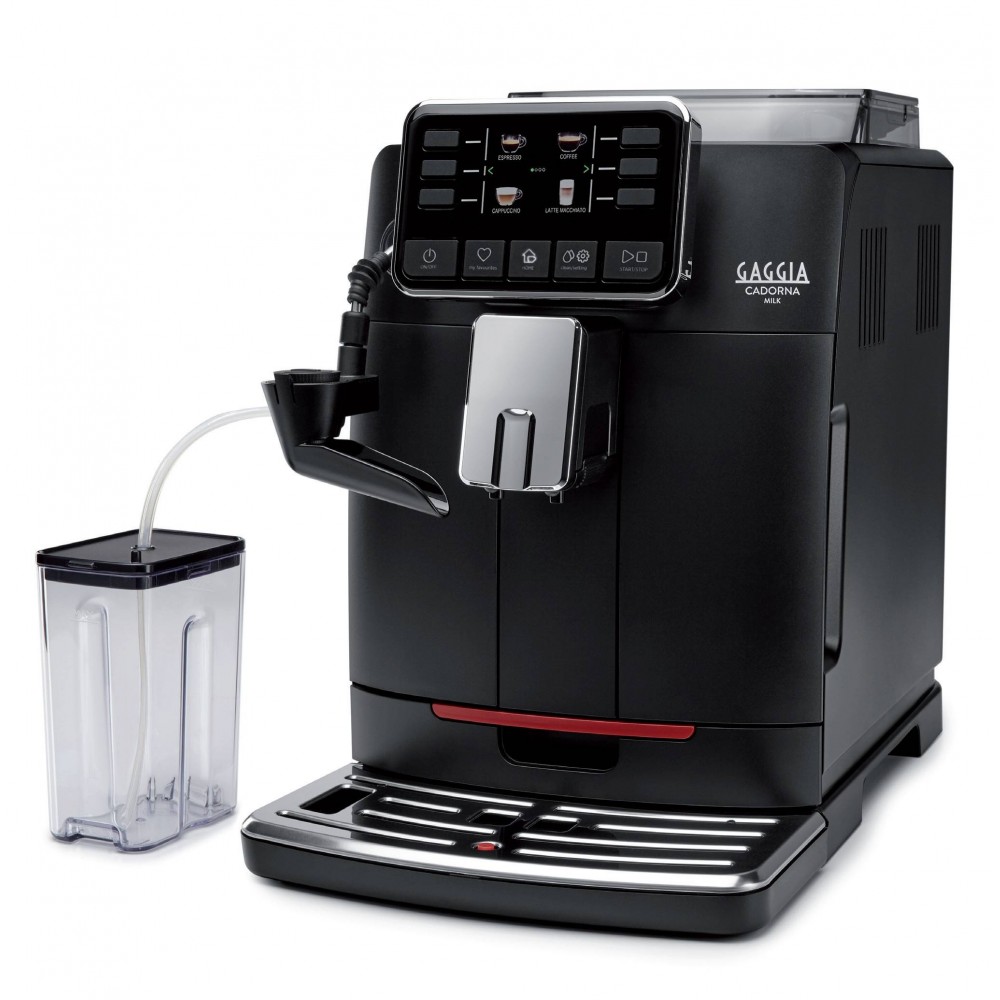
Gaggia is one of the popular models in the coffee lover industry; Gaggia manufactured many coffee and espresso machines that were beloved by lots of users. If you want to explore some of the latest Gaggia espresso machines reviews or coffee makers, visit EspressoTune
Cleaning Checklist: (once per month)
- Pull off the drip tray and rinse black rubber seal and underside of the drip tray in warm water. Spray with a bit of white vinegar and leave to air dry
- If the machine has been sitting unused for over two weeks, empty any water in the tank. Empty all coffee grounds from the brew funnel and filter holder. Rinse under running hot tap water, cleaning out any residue left inside
Underneath the Gaggia Brera:
Check that the drip tray is not rusted underneath – this can be cleaned off with some steel wool but check it regularly to ensure there is no long-term corrosion taking place!
Cleaner Maintenance Checklist (once per week)
1/ Turn on the machine and run one whole brewing cycle through (pressure & steam), keeping an eye on it to check that it is flowing freely through (but don’t push down the lever to brew; coffee will be wasted!)
2/ Run one rinsing cycle through the machine with hot water only – use around 3–4 x 200ml in total. Always make sure you run a rinse once per week to keep your Gaggia classic clean and efficient!
3/ Turn off the machine. Place a mug underneath the steam wand and screw on the steam tip, making sure no leaks occur.
4/ Run two whole cycles of hot water only through the espresso machine – both processes should be completed after each other without any break for at least 10 minutes. After this step, I usually like to re-try my first test extraction as cups of good quality fresh coffee will ensure the machine is really clean! This also helps to prevent any limescale build-up.
5/ Turn off the machine and remove the steam tip. Rinse it out in warm tap water, then place on a soft cloth and spray with cleaner or vinegar – this will remove any limescale that has built up on the wand. Then leave to air dry for 5 minutes (you can speed up drying time by leaving under a hot kitchen tap if you wish).
6/ Clean drip tray – use white vinegar mixed 50:50 with water sprayed onto the drip tray, rinsing well afterward as residue can cause discoloration of the plastic. The drip tray can also be washed in warm soapy water once per week (but if you do this, make sure to rinse well afterward and dry upside down to prevent watermarks or rust in the tray)
7/ If using a grinder, empty any beans collected around the grinder chute – it is a good idea to clean this out as often as possible! Remember that coffee beans will absorb smells from other foods if they are not stored correctly. Keeping your kitchen area clean and tidy can help prevent odors from getting into bean storage containers.

General Operating FAQs
Ensure the machine is unplugged when cleaning or performing maintenance on any part of the machine! (except for cleaning a steam wand, which can be done while plugged in).
Do not use harsh chemicals on gaskets – soak them in warm water and white vinegar first, then rinse well.
Any of the quick cleaning beverages can be used instead – look for citrus/ammonia based sprays in supermarkets (if you need to soak this type of product briefly in a bucket of warm water beforehand to help it penetrate stubborn dirt)
Q: Can I clean my machine with bleach?
No! Bleach will cause corrosion over time – use products that are specifically designed for cleaning coffee machines or just warm water.
Q: Can I run the machine without a milk frother?
Yes, but remember that if you do so, there will be residue left behind which could affect your taste in future espresso shots. If your machine is getting old and no longer pumps out as much foam as before, try running a cycle with hot water only (with the steam wand attached) to clean out any residue. If your machine still does not pump out foam as it used to, you may need to buy a new milk frother!
Q: Why do I get this white powdery residue at the bottom of my cup?
This is coffee scale build-up – make sure that filter holder and brewing unit are cleaned regularly and run one rinse cycle every week with hot water only through the machine (without any ground coffee or pods in place). Keeping your kitchen area clean will help prevent odours from being absorbed by beans stored under the grinder chute.
Q: Why do I have small brown flakes in my espresso shot?
These are coffee grounds that have been burnt in the internal boiler – this can be caused by the machine being left on for too long, or if you are using a grind that is too fine. Try running one cycle of hot water through the machine after each use (without any ground coffee) to help prevent scale build-up and remember to empty out the chute regularly.
Q: Is it normal to have steam coming from the steam wand?
Yes! The steam wand needs to ‘blow off’ now and then, so do not be alarmed when white vapor appears sporadically at first! This acts as a safety feature of your Gaggia Classic espresso machine – it is important that all parts are kept clean and free from any blockages (including the steam wand).
Q: Why can’t I turn my Gaggia classic on even though the green ‘on’ light is lit?
There could be a few reasons for this:
- You have not turned the power switch on at the wall.
- The machine has an internal fault
if this persists after you have unplugged it and left to sit for 10 minutes, then contact customer services. If in doubt, follow the steps in the troubleshooting guide below. A handy guide to understanding your Gaggia classic
Q: Is there anything that I really need to do/keep an eye on?
Yes! Make sure you regularly empty out the chute and rinse under hot water (you should also run one cycle of just hot water through your machine after each use to help prevent scale build-up). Grind needs to be fine enough to give you 28mls of the espresso shot. Use coarse grind for best results.
Q: What is the difference between loose leaf tea and bagged teas?
Loose leaves are created by drying the herbs, flowers, or spices right off their stems then crushing them into small pieces (or slicing if using leafy plants). Tea Bags are filled with smaller parts of the original plant/herb and do not contain dried material.

Q: My Gaggia classic dual boiler won’t stop steaming!
There could be few reasons for this:
- The steam knob may have been inadvertently left in the ‘steam’ position (this sometimes happens when you put the steam wand back in its tray).
- The machine may not be properly ‘primed’ – try turning off and then plugging in again.
Q: Why is there a loud knocking noise coming from my Gaggia classic?
There could be several reasons for this:
- You have left the machine on for too long – turn it off at the wall or unplug. This can also happen if the water level is too high in the tank and boiling over onto the boiler (this will often make a hissing sound as well).
- The internal boiler may need descaling – see below for information on how to do this safely with products specifically designed for cleaning coffee machines.
Q: Can I clean my Gaggia classic dual boiler by descaling?
Yes! Please use products specifically designed for cleaning coffee machines. Please follow instructions carefully and if in doubt, contact customer services.
Q: Can I leave the water tank on the machine when not using it?
No! The water needs to be removed from the internal tank and the external water tank, then rinsed out with hot water and dried before storage. If you do not do this, then mold may start growing inside of your tanks – also, if you have a hard time getting your machine ready for use next time (due to scale build-up), this is why!
Keeping your kitchen area clean will help prevent odors from being absorbed by beans stored under the grinder chute (this will make your grinds taste stale).
Q: How long can the steam wand be left on before it starts to drip?
If you are not using the steamer, turn it off and leave in the ‘reheat’ position. It is best to use the steaming feature intermittently – if you allow water to sit in there for too long, it could result in scale building up and then bursting out of the tip, which would damage your machine!
Steam should only be applied with light pressure ie: over-packing your espresso shot or pouring directly into hot milk might cause water droplets to burst out of the end of a steam wand – this is not a fault (and can happen with other coffee machines/steam wands).
Q: My heads-up display is flashing an F – what does this mean?
This may be due to scale build-up or water overflowing in your internal boiler. If you can, turn off at the wall, then leave for 2 hours and try again. If not, contact customer services.
Sometimes moving the lever back and forth a few times before removing it from the steam wand will help dislodge any blockages that have collected inside of the machine (this is where most clogs occur).
Q: How often should I descale my gaggia classic dual boiler?
Every 3 months using products specifically designed for cleaning coffee machines (this helps prevent gumming up of valves which can damage your machine), however, if there’s no change after performing the running descaling process twice, you should contact customer services.
[NOTE: This applies only to the *Gaggia classic* machine – newer models of dual boiler machines do not need to be cleaned as often and can go up to 6 months before cleaning is needed.]
Q: What are my gaggia classics accessories for?
The plastic needle in the lid is to keep the portafilter ‘floating’ on its hinge, ie: if it’s removed, then the portafilter will drop down/off track – but this also prevents any milk that may have dripped. Down onto the countertop from being sucked into the portafilter (yuck!)!
The hand tamper that comes with your machine is used for firmly packing espresso shots. Don’t overpack shots, as this can cause clogging and require extra time to hand tamper down before getting espresso. Plus, you don’t want over-roasted coffee oils in your shot! The tamper that comes with the machine is also used for decalcifying the internal boiler.
Q: What are my Gaggia classics steam wand attachments for?
These heads are designed for frothing milk only – they were not designed for making steamed milk drinks such as cappuccinos, etc. Please follow instructions carefully and if in doubt, contact customer services.
Q: What type of beans should I use in my Gaggia classic?
All different types of beans have different flavors and will produce varying levels of pressure when tamping them, so it’s up to you. However, if you want as little oil in your shot as possible, then I don’t really recommend decaf (as this has high amounts of caffeine) or beans from the ‘arabica’ family.
The best type of bean to use is one of the Robusta varieties – these will produce a creamier tasting espresso due to higher amounts of oils and gas present within them. You should also clean out your portafilter after every use with warm water – this helps reduce the build-up inside your machine.
Q: How do I fix the leaky flask valve?
This sometimes happens when using pressurized stainless steel flasks, but they can be easily fixed by removing them from the machine – then turning them upside down onto a kitchen towel that is placed into the sink.
The valve will unseat itself from the valve block and can be easily replaced (the seal between the two parts of this device has shrunk slightly and needs to be redistributed).
You should allow time for drying before using again, however, if you find it hard to dry out, then unscrew the base from the hot water tank, place upside down on kitchen towel in the sink and turn on cold water – leave running until most of the condensation gone.
Q: What type of coffee mugs are best to use?
Stainless steel or glass ones can be used with your Gaggia Classic. A lot of cheap plastic/porcelain mugs (especially those that have molded handles) may not work as they don’t have as much mass to them, and they may crack under the pressure of espresso shots being extracted.

Q: How often should I descale my thermal flask?
This depends on how often it’s being used, what you’re putting into it etc – but once a month or so is good.
The water that comes out of these machines has small amounts of calcium in it (this can be removed by using vinegar after your first cycle), which will cause corrosion over time if left unchecked, plus this will also affect the taste! It’s best if the machine is cleaned with products designed for cleaning coffee makers every three months.
Also, remember that milk residue from frothing may also have some caustic properties, so try not to allow it to sit in your machine for long periods of time.
Q: How do I descale my Gaggia classic?
When your machine has finished brewing, remove the in-built filter, press two buttons on the front, take out portafilter and empty all water from the brew head into the sink (make sure that the hot water tap is turned off if you are doing this is so that you don’t burn yourself).
Now fill up the hot water tank to the top with warmish water (40c – 50c will be fine), place your portafilter on the brew head, making sure that it’s well seated, and then press the brew button until the tank is empty.
If the water in the brew head feels sticky or oily – then repeat once more. Don’t use this first flush to make coffee, as it will be very milky.
Now put used coffee grounds into the top of the machine, place portafilter back into the brew head, and fill up with water again (this flush will be normal coffee later on).
If your machine does not have a hot water tank then remove base from the unit, empty all water, including the bean container, into the sink – leave out for 3 hrs. Put used coffee grounds into the top of the machine, place portafilter back into the brew head, and fill up with water again.
Note: If you have a glass or plastic pot, then make sure it’s empty before running through the descaling process.
The Benefits of Pasture Raised Chicken
April 12, 2024Tips on What to Buy as a Perfect Housewarming Gift
February 19, 2022What are the best online wine auctions houses?
December 27, 2021
Comments are closed.
-
The Rolex Submariner: Everything An Owner Should Know
August 26, 2022 -
UNDERSTANDING TRAFFIC ENGINEERING COURSES
January 7, 2022 -
Play myfab11 and GetMega if you love playing in big groups?
November 5, 2021






